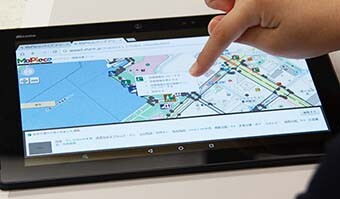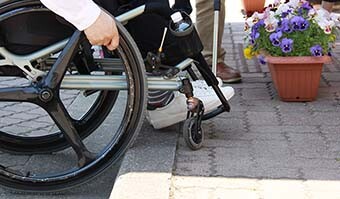Microsoft ends support for Internet Explorer on June 16, 2022.
We recommend using one of the browsers listed below.
- Microsoft Edge(Latest version)
- Mozilla Firefox(Latest version)
- Google Chrome(Latest version)
- Apple Safari(Latest version)
Please contact your browser provider for download and installation instructions.

In recent years, many overseas tourists have been visiting Japan, with more than 40 million visitors anticipated in 2020 according to a Japanese Government announcement issued in January 2018. To ensure that foreign tourists visiting Japan enjoy their trip in comfort, NTT is implementing various initiatives utilizing cutting-edge technology.
Table of Contents
Technology for analyzing human flow
It is predicted that in 2020, even more people than anticipated will gather at train stations and sporting venues. Of course, the same is also predicted for international airport terminals, where overseas visitors mingle with Japanese people returning home. In places where many people gather, there is the possibility of congestion and confusion occurring, leading to accidents; thus it is necessary to be able to guide people so that they can move about in safety and comfort.
In order to prevent accidents from happening, it is essential to gain understanding of the flow of people in the entire area in real time and predict congestion (which is caused by complex factors) in advance and formulate appropriate measures, then guide people intelligently in accordance with these measures. NTT is implementing initiatives aimed at optimizing such "human flow."
Initiatives at international airports, the gateways to Japan
In August 2017, NTT began implementing public verification experiments at the international terminal of Tokyo International Airport (Haneda Airport), a gateway to Japan. "Human flow" is automatically measured using video images and the content of information displays changes automatically in accordance with predicted congestion status based on measurement results, thereby supporting the realization of "universal design of ICT" provided through projectors, digital signage, and other devices. By measuring and visualizing congestion status in real time through the incorporation of mechanisms for not only collecting data real time but also utilizing airport facility operation schedules, NTT is aiming to level congestion and increase satisfaction among airport users.
 Human flow guidance via dynamic signs incorporating technology for measuring human flow using image recognition (TIAT 3F Departures Entrance)
Human flow guidance via dynamic signs incorporating technology for measuring human flow using image recognition (TIAT 3F Departures Entrance)
In September 2018, NTT introduced "NariNAVI", the first high-precision indoor navigation app service that can be used inside an airport terminal in Japan, at another major gateway to Japan--Narita International Airport. The indoor location technology used in this app is "geomagnetic positioning". This technology enables users to know their current location on a map shown on their smartphone in real time, even if they are in a part of the terminal where GPS waves do not reach. Moreover, the map display also incorporates NTT's "Map Platform Technology" that realizes "2.5D maps" three-dimensionally showing the complex interior of the terminal building, extending over multiple floors, in addition to conventional 2D floor maps. Thus NTT is providing support for travelers' smooth movement through maps that are intuitive and easy for users to understand. Coordination with the next-generation interactive digital signage "infotouch" that was introduced at Narita International Airport in October 2017 provide functions enabling route search results to be exported to the user's smartphone, multilingual services, "a My Flight" function that notifies the user when boarding has begun for their flight, and numerous other services. Thus NTT is providing support for the many international visitors and other travelers passing through Narita International Airport to spend their time in the terminal comfortably and enjoyably, without confusion.
 Image of "NariNAVI"
Image of "NariNAVI"
New verification experiments in conjunction with railway companies
NTT has also begun initiatives aimed at optimizing transportation systems used by large numbers of tourists. In collaboration with Kintetsu Railway Co., Ltd., NTT has begun verification experiments aimed at the commercialization of sightseeing services for overseas visitors to Japan that incorporate multiple AI technologies. We are developing smartphone apps that enable visual guidance using intuitive operation, without relying on language.
A Wi-Fi environment has been constructed at Kintetsu Nara Station, and a "Multimodal Agent AI" service for foreign tourists that combines the "Chatbot" interactive AI function and "Kazashite Annai®" image recognition function. Factors such as service usage frequency, user satisfaction, and degree of ICT environment usage comfort are being analyzed with the aim of realizing new sightseeing guide services.
Application of human flow analysis technology at sporting venues
At sporting venues where international sporting events are held, NTT also conducted verification experiments applying our human flow analysis technology and technologies developed by partner businesses. At and around the Saitama Super Arena"--which is a Tokyo 2020 venue--verification experiments were conducted for a "mobility optimization system" to guide visitors smoothly. Using cameras and mobile telephone location information, systems for analyzing and predicting congestion status were analyzed.
Collecting Barrier Information
Among foreign tourists visiting Japan, there are also people with disabilities. To enable a diversity of people to enjoy traveling without being experiencing barriers, in April 2016 NTT began collecting barrier information and creating map data from routes between railway stations and sporting venues where mega sporting events are held in Japan in collaboration with local governments and businesses. Volunteers participated in these data-collection efforts, conducting surveys of factors such as the incline of roads and existence of steps/differences in road level as they walked around, as well as facilities such as universal toilets. As of August 2018, some 213,600 pieces of barrier information have been collected and made public via the online map "Japan Walk Guide".
In collecting this barrier information, NTT's technology for surveying accessibility information "MaPiece®" is being used. "MaPiece®" enables even people without specialized knowledge to collect street information simply by walking along holding a smartphone, thus creating an environment in which first-time volunteer participants were able to conduct surveys without difficulty.
-
 Collecting information using "MaPiece®"
Collecting information using "MaPiece®"
accessibility information surveying technology. -
 Difference in surface level of
Difference in surface level of
2 cm or more poses an obstacle to people in wheelchairs
Approaches to transportation systems
In anticipation of public transportation congestion and an increase in the number of foreign tourists hiring rent-a-cars, urban transportation systems are being smartified. In city areas where many tourists and vehicles come together, human and vehicular flows are being optimized through Big Data analysis and the application of smart navigation technology. NTT is undertaking R&D for predicting traffic congestion and controlling traffic lights using AI, endeavoring to realize smart cities while repeatedly carrying out verification experiments.
NTT is also undertaking initiatives that will lead to the prevention of traffic accidents, such as safe bus driving support and self-driving bus operation support through the use of wearable sensor/sensing technology and AI with busses and other public transportation.
With the goal of creating an environment in which all tourists can enjoy travel in comfort as well as feel pleased to have visited Japan, NTT will continue to provide methods for utilizing cutting-edge technology.












